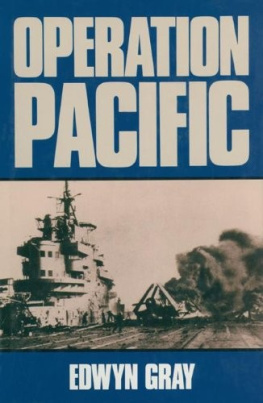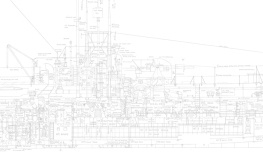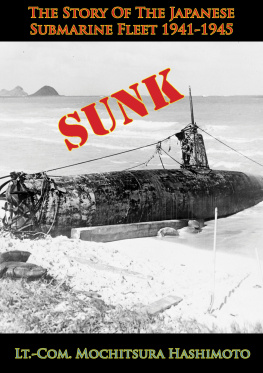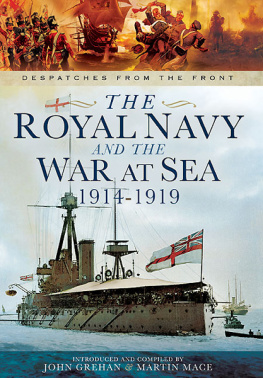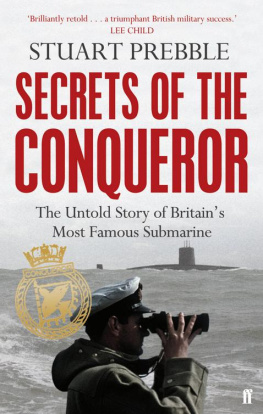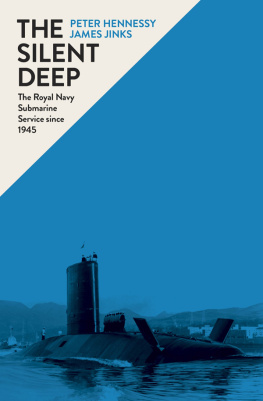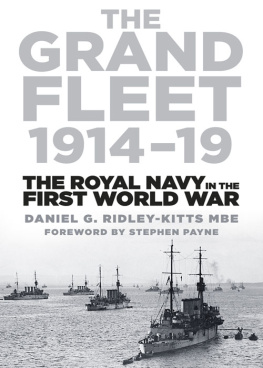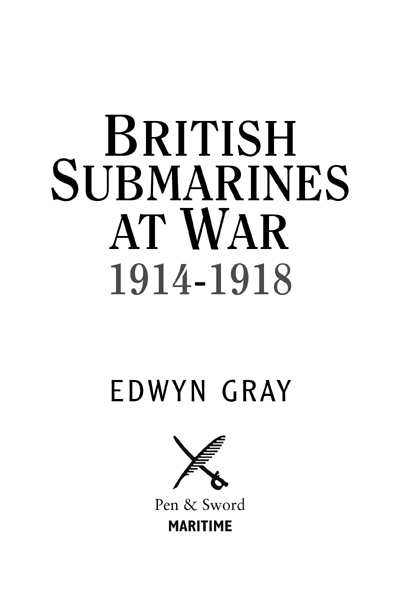
First published in Great Britain in 1971 by Charles Scribners Sons
Republished in 2001 and again in this format in 2016 by
PEN & SWORD MARITIME
An imprint of
Pen & Sword Books Ltd
47 Church Street, Barnsley
South Yorkshire
S70 2AS
Copyright Edwyn Gray, 1971, 2001, 2016
ISBN: 978 1 47385 345 4
PDF ISBN: 978 1 47385 348 5
EPUB ISBN: 978 1 47385 346 1
PRC ISBN: 978 1 47385 347 8
The right of Edwyn Gray to be identified as Author of this work has been
asserted by him in accordance with the Copyright, Designs and Patents Act 1988.
A CIP catalogue record for this book is
available from the British Library
All rights reserved. No part of this book may be reproduced or
transmitted in any form or by any means, electronic or mechanical
including photocopying, recording or by any information storage
and retrieval system, without permission from the Publisher in writing.
Printed and bound in England
By CPI Group (UK) Ltd, Croydon, CR0 4YY
Pen & Sword Books Ltd incorporates the Imprints of Pen & Sword Aviation,
Pen & Sword Family History, Pen & Sword Maritime, Pen & Sword Military,
Pen & Sword Discovery, Pen & Sword Politics, Pen & Sword Atlas,
Pen & Sword Archaeology, Wharncliffe Local History, Leo Cooper,
Wharncliffe True Crime, Wharncliffe Transport, Pen & Sword Select,
Pen & Sword Military Classics, The Praetorian Press, Claymore Press,
Remember When, Seaforth Publishing and Frontline Publishing.
For a complete list of Pen & Sword titles please contact
PEN & SWORD BOOKS LIMITED
47 Church Street, Barnsley, South Yorkshire, S70 2AS, England
E-mail:
Website: www.pen-and-sword.co.uk
CONTENTS
MAPS
Drawn by Boris Weltman
ILLUSTRATIONS
The author and publishers are grateful to the following for permission to reproduce the copyright illustrations: The Imperial War Museum, Nos. 1, 4, 5, 6, 7, 8, 9, 10, 11, 13, 14, and 18; Lord Keyes, No. 12; The Mansell Collection, No. 15.
Authors Note
WHEN, IN 1620, the Dutchman Cornells Drebbel sailed up the Thames in the worlds first submarine and calmly dived under the water while he kept the King and several thousand Londoners in the greatest suspense, no one in the watching crowd could have foreseen where his invention would lead.
Today, the nuclear-powered missile-submarine stands supreme as the worlds most powerful warship. Able to circumnavigate the globe without surfacing, it can sail beneath the polar ice-caps, and travel 120,000 miles without refuelling. And, at the touch of a button, its megaton destructive power can obliterate half a continent.
Not surprisingly, many things have happened in the history of the submarine since that day, 350 years ago, when Drebbel first submerged his primitive boat in the Thames. This volume deals only with that part of the story between the years 1900 and 1918 and it recounts the dramatic history of the Royal Navys early submarines and their pioneer crews during the First World War when the traditions and legends of the modern Submarine Service were created.
The story has been written mainly for the general reader who has neither the facilities nor time to ferret facts from the hundreds of naval histories in which they hide and, for this reason, footnotes and technical details have been omitted. I hope, however, that the serious student of naval affairs will discover many new facts and that he will gain a fresh insight into the scope and effect of British submarine operations in the First World War.
I would like to acknowledge my personal debt to the many authors and historians who, since 1918, have unravelled the complex details of the submarine story for without their hard work and painstaking research this book could not have been written. I must also thank Associated Book Publishers (International) Ltd for allowing me to quote extensively from the naval memoirs of Sir Roger Keys, and to Cassell & Co, Hodder & Stoughton Ltd, HM Stationery Office, Doubleday & Co. Inc., The Hamlyn Publishing Group Ltd, George G. Harrap & Co Ltd, Hutchinson Publishing Group Ltd, Faber & Faber Ltd, and Rupert Hart-Davis, for permitting me to use their copyright material. I am grateful, too, to M. Brennan, Photographic Librarian of the Imperial War Museum, and his staff, for their willing assistance in tracing the photographs.
Like all writers I owe a great deal to those who helped me on the background work and research including my father, Dr A. E. Gray, who assisted with the maps and diagrams.
Finally may I express my admiration for the gallant crews of the British Submarine Service whose stirring deeds made this history possible. May this book stand as a humble tribute to those who never returned.
EDWYN GRAY
Attenborough,
Norfolk.
November, 2000
CHAPTER ONE
A Damned
un-English Weapon
SO FAR AS the Royal Navy was concerned the war against the Boers in 1900, was a mere side-show of no interest to anyone except, possibly, the soldiers concerned and the halfpenny Press.
The enemy had no warships and their erstwhile allies, despite the sabre-rattling threats of Kaiser Wilhelm II, had no desire nor intention of disputing Britains sea power. Only the shuttle service of steamships carrying troops and supplies to Cape Town and returning home with the sick and wounded, served to remind the complacent admirals that England and her Empire were fighting a bloody war.
Not that the sailors themselves failed to support their comrades in the field. HMS Powerful, diverted en route from China, landed half a battalion of the Mauritius garrison at Durban, and played a crucial role in the defence of the Cape Colony. Her prompt action, however, was not taken on receipt of orders from the Admiralty, but stemmed from the personal initiative of her Commanding Officer, Captain Lambton. Not content with acting as a mere troop ferry, Lambton sent a contingent of the cruisers own Bluejackets to help the defenders of Ladysmith.
With similar enterprise Percy Scott, captain of the Terrible, landed a number of 45 pdr naval guns, equipped with wheeled carriages of his own invention, to add the Navys fire-power to the Armys pitifully inadequate artillery. He also devised and manned an armoured train, but what their Lordships had to say about a gold-braided Captain operating a railway is unfortunately not known.
Officially the Royal Navy did nothing, except to criticize the mistakes of the generals and bemoan the Armys system of command. Admiral Fishers comments in a letter two years after the war typify the seamans view: its almost inconceivable blunders our Army of Lions led by Asses so needlessly slaughtered.
The Admiralty had its own problems. The Naval Estimates had been presented and considerable pressure was being exerted by the Press and public for the Navy to take an interest in the new-fangled submarines which the French were developing. At the turn of the century France, not Germany, was still regarded as our main potential enemy and the Fashoda Incident was still fresh in the minds of many.
During the Debate on the 1900 Naval Estimates, George Goschen, the First Lord of the Admiralty told the House: The submarine boat, even if practical difficulties attending its use can be overcome, would seem to be eventually a weapon for Maritime powers on the defensive.
Nevertheless, when the First Lord received a note to say that a certain Mr Rice of the American Electric Boat Company was in Europe, he was more than anxious to see him, for he already knew that the American company had taken over Mr Hollands patents for a prototype submarine and could now produce a workable model. He was also well aware that the United States had adopted this form of underwater defence a few months earlier. But he knew, as well, that the professional heads of the Royal Navy would oppose any suggestion emanating from a mere civilian on principle.
Next page

